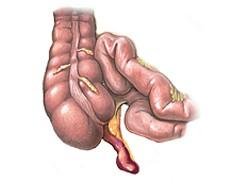
Causes of Appendicitis
Although the exact cause of appendicitis is unknown, it is usually associated with some occurrences in the body, such as:
- Blockage of the appendix by hardened stool, mucus, foreign object or seldom, a tumor
- Swelling of the lymphatic tissue leading to blockage
- First theory:
- After blockage, it is thought that the bacteria inside the appendix invade the wall
- As a response, the immune system causes it to inflame leading to inflammation
- Second theory:
- After blockage, rupture occurs and is followed by spread of bacteria outside the appendix
Symptoms of Appendicitis
Symptoms will vary during the different stages of life, however, the general symptoms are the following:
- Initially, minor pain around the belly button. But as swelling grows, the pain becomes more sharp and intense, which has already moved to another location at the lower right abdomen. Severe pain usually occurs 12 to 24 hours after the onset of inflammation.
- Nausea and vomiting
- Loss of appetite
- Abdominal tenderness
- In cases of severe appendicitis:
- Fever and chills
- Shaking
- Constipation
- Diarrhea
Complications of Appendicitis
An appendectomy must be performed immediately to avoid any serious complications, which can be life-threatening.
- Ruptured appendix
- Decreased pain for a short while
- Abscess
- Pocket of infection around the appendix
- Peritonitis
- Infection of lining of the abdominal cavity
- Increased pain when walking or coughing
Diagnosis of Appendicitis
There are many ways to diagnose appendicitis in a patient. It may be difficult to diagnose due to the different size and precise location of the appendix. It may be hard to distinguish appendicitis from other abdominal and pelvic ailments.
- Urinalysis
- White blood cell count
- Abdominal x-ray
- Barium enema
- Ultrasonography
- Laparoscopy
- CT scan
First Aid Management of Appendicitis
After diagnosis, it is essential to take antibiotics and surgery to
remove the appendix, also called appendectomy. However, when one begins to feel abdominal pain, it may not necessarily be a medical emergency and can be treated at home. At the onset of abdominal pain, a number of things should be done and observed before seeking emergency medical services.
- If possible, try to identify the cause of pain. Find the location of the pain and record the duration. Keep a diary.
- Ask the person to rest and lie down to see if the pain disappears. A painkiller may be given.
- If any of the symptoms mentioned above were observed, seek emergency medical attention immediately.
- Do not give milk and caffeinated drinks.
Disclaimer: The information provided above does not substitute for diagnosis. The purpose of this article is information. To learn how to recognize symptoms of appendicitis and others which involve abdominal painpain, register to join in first aid training and CPR courses.